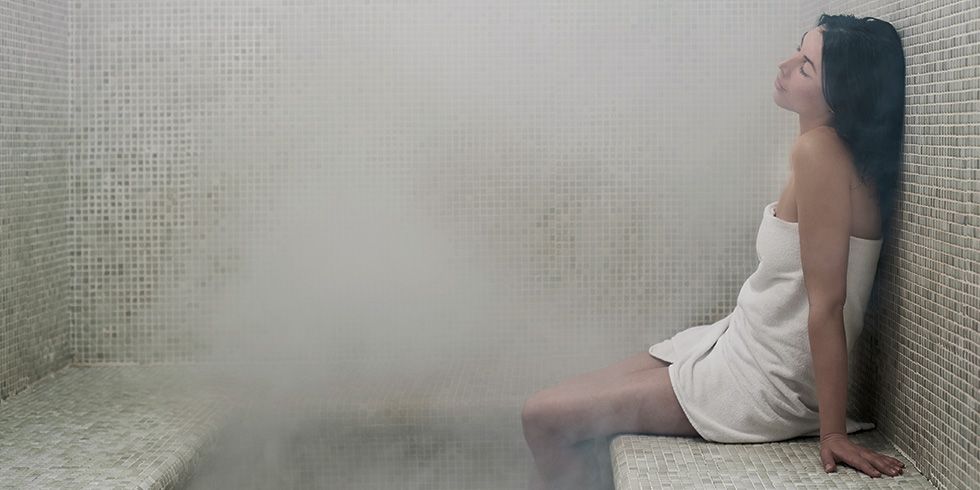Being too hot can feel kinda miz: the sweating, the red face, the feeling like your skin might either melt or dry up any second. Yet people *love* saunas and steam rooms. And it turns out, the sweltering chambers might have some legit health benefits, says Dr. Chiti Parikh, co-director of the integrative health and wellbeing program at New York Presbyterian Weill Cornell Medical Center.
But when it comes to saunas versus steam rooms, is one better than the other for your overall wellness? And how do you choose the one that’s best for you? Let’s get into all the sweaty details.
All right, what’s a sauna?
Saunas use a dry heat. They’re typically heated between 180°F and 195°F with very low humidity, heated by wood, gas, electric, or infrared technology (a.k.a., using light to create heat).
“It’s like sitting in an oven,” says Dr. Parikh. That’s why people often pour water over heated rocks in a sauna room—it creates steam for a little bit of humidity, she says.
What are the health benefits of sitting in a sauna?
Research on the use of dry saunas has shown that they can provide certain health benefits.
1. Improved circulation
Anything that increases your body temperature will increase your heart rate, which in turn increases your circulation, says Denise Millstine, MD, an internist at Mayo Clinic’s family medicine office in Scottsdale, Ariz.
Sitting in a sauna is almost like walking on a treadmill at a regular pace, says Dr. Parikh. Because of the heat, your heart has to pump harder to circulate your blood, which means you’re getting some cardio benefits even though all you’re doing is sitting in the heat. (Keep in mind, though, it’s still no replacement for exercise, which has tons of other body-benefits.)
2. Lowered blood pressure
Spending time in a sauna can lower your blood pressure, says Dr. Millstine,but you wouldn’t want to go into a sauna if you have uncontrolled blood pressure.
“Studies have shown that traditional Finnish sauna bathing is associated with overall lower blood pressure when people are using it regularly, she explains. “So physiologically, much like exercise, your blood pressure would go up initially and then long-term, it would likely result in better management of your blood pressure and a lowering of your blood pressure.”
In fact, people can see improved cardiovascular health from sauna use. Research shows that shows people who regularly use a sauna (at least four times a week for 20 minutes) have a significantly lower risk of heart attack, stroke, and dementia, notes Dr. Parikh.
3. Stress relief
Sauna bathing is a regular part of Scandinavian culture, says Dr. Millstine, and is viewed as a way to destress and relax.
“If using a sauna becomes a regular practice for you and it’s something that you can do fairly easily, such as on your way from home from work for a brief session, or if you’re able to socialize while doing it, it likely will reduce your stress levels,” she says.
4. Glowy skin
Using a sauna can benefit your overall skin health, as it’s bringing blood flow to the surface of your skin before you start sweating.

“Regular sauna use makes the skin more robust, meaning it sort of firms it up and makes it more elastic, which is good for aesthetic reasons, but also because the skin acts like a general health barrier,” says Dr. Millstine.
5. Relief from stiff joints and sore muscles
Using a sauna is beneficial for workout recovery, as it’s going to result in loosening up any tense muscles after a workout.
“The heat can make your muscles more pliable and elastic, so it would probably help with workout recovery soreness,” she says. Anecdotally, people with stiff joints and body aches also swear by saunas for easing pain.Sauna use can also help with tension-type headaches, likely because it reduces muscle soreness that contributes to them, says Dr. Millstine.
6. Stronger immune system
Using a sauna isn’t directly tied to boosting immunity, but if you associate sauna bathing with relaxation, it will reduce stress, which can impair your immune system’s function. Sauna usage has also been shown to decrease circulating levels of inflammatory markers, which mess with your immune system response too.
“There was also a small study that looked at sauna use in some healthy volunteers and they were able to show reduction in their incidence of the common cold,” says Dr. Millstine. “So it’s possible that it can help to improve your immune system or potentially make your tissues better able to fight off a virus that you’re exposed to.”
7. Improved mood
Some studies show that sauna sessions can benefit your mood, which could, again, be tied to the relaxation factor. However, men in Finland who regularly used a sauna had a decreased risk of psychosis, found one study, and sauna usage can reduce the risk of dementia and Alzheimer’s disease, another study showed.
“It’s unclear if those benefits are directly related to sauna use or, again, or if it’s simply tied to a healthy lifestyle that involves socialization and relaxation,” says Dr. Millstine. Either way, there seems to be some positive brain and mental health benefits to visiting a sauna.
What’s a steam room, then?
Basically, steam rooms aren’t as hot as saunas, and they’re much more humid. Typically, steam rooms are heated between 100 and 120°F and have nearly 100 percent humidity, says Dr. Parikh. But even though they aren’t technically as hot, you’ll likely feel the heat more in steam rooms than in saunas because of the humidity.
What are the health benefits of steam rooms?
Steam rooms have all the same health benefits as saunas, because the effects of heat are the same whether it’s a dry heat or a moist heat, says Dr. Parikh. This means you’ll still get some cardio benefits, along with lessened pain and stiffness.
But don’t get your hopes up in the weight loss department. Any actual pounds dropped will be water weight, you know, because of sweat—and that goes for both the sauna and the steam room.

Another myth? The idea that you can detox from a night of drinking in a steam room. You can sweat off product on your skin, like sunscreen, but simply sweating won’t help your body process something you’ve ingested, like food or alcohol, says Dr. Millstine.
There is, however, one extra benefit to steam rooms for anyone who has respiratory problems like asthma or allergies. “Medications for these kinds of respiratory problems might dry out your breathing passages,” says Dr. Parikh. “Steam will moisturize and open the lungs a little more and hydrate the respiratory tract.” If you struggle with congestion, the steam can also act as a humidifier and help clear your nasal passages for easier breathing.
Are there any risks to using a sauna or steam room?
As far as risks go, you’re mainly looking at dehydration and dizziness from the heat, says Dr. Parikh. So it’s important to make sure you’re well-hydrated before and after your sauna or steam room session. You’ll also want to skip the sauna if you’ve recently had a heart attack or any other cardiovascular issues, like high blood pressure, since it increases your heart rate, adds Dr. Parikh.
How long can you sit in a sauna or steam room?
Most people’s sessions are only five to 30 minutes. But how long you can safely use a sauna or steam room depends on how acclimated you are to it, or how hot the sauna or steam room is.
“If you feel lightheaded or you’re feeling dehydrated because you perhaps just came back from a long run, it’s not a good idea to spend a long time in the sauna,” says Dr, Millstine. “But if you’re well-hydrated and feel fine, you can stay a bit longer.”

It’s also common practice to get out of the sauna or steam room for frequent breaks, so leave and drink water whenever you feel you need to, she says.
Dr. Parikh suggests starting low and slow. The lower you sit in the sauna or steam room (i.e., the closer to the floor), the less intense the heat will be because heat rises. While it’s best for your health to use a sauna or steam room regularly (several times a week, if you can), maybe start with one trip to the spa for no longer than five or 10 minutes at most to see how well you can handle it, then add on from there.
What should you wear in a sauna or steam room?
When it comes to shared public steam rooms or saunas in the U.S., most people prefer to at least wear a towel, but if you’re lucky enough to have one in your own house, you’ll likely be more comfortable going naked. If you do prefer to wear clothes, natural fibers such as a cotton towel or loose-fitting shirt will likely be most comfortable, says Dr. Millstine. If you are at a gym that allows for nudity in the sauna or steam room, you’ll still want a towel to sit on, she notes, since these areas can be breeding grounds for germs.
Should I choose a sauna or a steam room?
Again, if you have respiratory issues, it’s best to stick to steam rooms in order to keep your respiratory tract hydrated (a sauna might dry it out even more), according to Dr. Parikh. Otherwise, it’s all about personal preference, and you get get health benefits from both.
The bottom line: Saunas and steam rooms offer many of the same benefits (and risks), so it’s all about personal preference and finding out which one works best for you.
Source: Read Full Article
